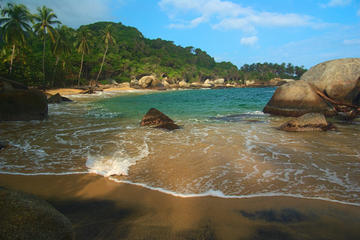
Tayrona National Park
Tayrona National Park, just 34 km from Santa Marta in northern Colombia, has abundant natural and archaeological attractions. Named after one of the most important indigenous tribes in Colombia’s history, the Tayrona National Park was established in 1969 with an area of 19,000 hectares.
Eco-tourism is popular in this complex biological ecosystem. There are over 300 bird species, including the endangered Andean condor and woodpeckers. Puma, deer, bats, howling monkeys, iguanas, jaguars and marine turtles also call this forest home. Hikers can spot multicolored land crabs, reptiles and butterflies on the trails.
To get to the beaches, visitors walk along marked trails or hire a guide with horses. Explore the many golden sand beaches and snorkel near coral reefs and underwater treasures hidden around the huge rock formations.
The largest archeological remains in the park are found in Pueblito, an ancient commercial center used by the Tayrona Indians of the Sierra Nevada. It is estimated that it was inhabited by about 2,000 people between 450 and 1,600 A.D. Since the hike only takes about 2 hours, these ruins are a good alternative to observe the architecture of the Tayronas if you don't have enough time or the physical condition to visit the Lost City. And for many travelers, the trek through streams and past giant boulders is more of an attraction than the destination itself. Remember that the trails are often muddy, so it’s advisable to wear suitable walking shoes.
Lodging in Tayrona Park is also exciting, ranging from hammocks to luxurious eco-habs inspired by indigenous dwellings. Remember there’s no electricity in the park at night, so flashlights are useful.
Practical Info
A bus, taxi or shuttle can be taken from Santa Marta or Tanganga to get to the park. The use of motorized vehicles is restricted within the park, but make sure your transportation drops you off at the head of the trail, not at the park entrance. Many visitors bring their own food, water, sunblock, toilet paper and insect repellent.
